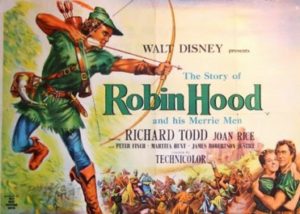The Story of Robin Hood and His Merrie Men
Rating: ****
Origin: USA, 1952
Director: Ken Annakin
Source: Disney DVD

After the success of Disney’s Treasure Island (1950), Walt decided to continue the studio’s live-action adventures with Robin Hood, another well-known (and public domain) property. Since 1938 every Robin Hood movie had stood in the shadow of the towering Errol Flynn film, but this was to be a restart, a resetting of the legend for the safe and conformist ‘50s. In this telling Robin (Richard Todd) is infantilized: when we meet him, he’s a lad playing juvenile archery games with Maid Marian (Joan Rice) while his father, the chief forester for the Earl of Huntington, meets with the other grown-up, bearded, manly men to prepare for what manly men do, which is go to war. The earl—Marian’s father—is eager to follow his own father-figure, King Richard, off to fight in the Crusades. Big Daddy Richard leaves behind Prince John, in this version hardly older than a lad himself, enjoining him to mind the kingdom in his absence, and the earl does the same for his domains with his forester, Fitzooth.
The kids had been warned to play nice while the daddies are gone, but John would rather be a bully, so there. Since Richard took the manly, bearded old Sheriff of Nottingham with him on Crusade, John appoints his crony Guy of Gisbourne to be the new sheriff (a convenient combining of characters), and orders him to build a force of the finest archers in the land. The sheriff hires a few ruthless goons who begin plundering the peasants to collect John’s new extortionate taxes, but he needs more, so he organizes an archery tournament to overawe the serfs and attract more bowmen. Now, in the Robin Hood legend, Robin is usually the finest archer in all England, but here it’s his own father who splits Robin’s arrow and wins the tournament. Daddy knows best! However, loyal to Big Daddy Richard, Fitzooth refuses to join John’s tax collectors, so the sheriff has him murdered, Robin kills the assassin, and then, proscribed, has to go off into the woods and play outlaw with the other bullied boys.
The wild and dangerous edge that Flynn brought to Robin Hood is gone here: Todd is a Boy Scout with a junior executive haircut and a smile from a toothpaste commercial, and Basil Rathbone would eat him for lunch and carry off Maid Marian for dessert. Such carping criticisms aside, on its own terms this movie is a pretty good retelling of the Robin Hood story, successfully establishing the tone and template that would rule the remakes for a decade or so, especially the popular Adventures of Robin Hood TV show that would run from 1955 through 1959. Shooting the film in the forests of old England rather than the California woods gives the film an authentic feel, and as he showed with Treasure Island, director Ken Annakin is equally adept with character development and action scenes. The Merrie Men are all charming and well-cast, and the clever use of the minstrel Alan-a-Dale to provide segues in song from one scene to another works well. The climactic fight between Robin and the sheriff is genuinely suspenseful, and if the violence isn’t as gritty as in Treasure Island, it’s less bland and bloodless than it will be later in the ‘50s. Marian even gets to join with the Merrie Men for a while and play in their secret clubhouse—so long as she dresses up like one of the lads and doesn’t do any icky girl stuff. Ew!